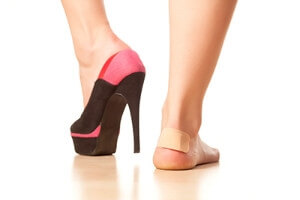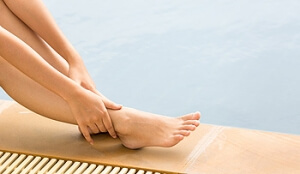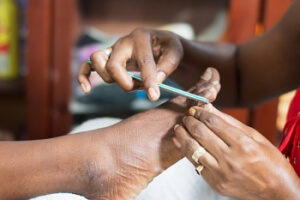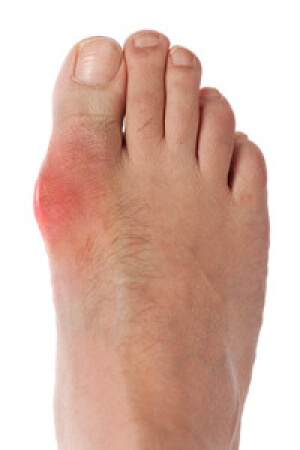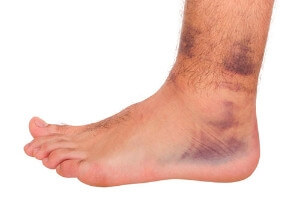Super User
Why Does My Child Have Flat Feet?
 A child’s foot will typically change shape as the aging process occurs. Most babies are born with flat feet, and the arch will be fully developed at approximately eighteen years of age. When children begin to walk, their feet may become less flexible as the bones become stronger. Research has indicated that it may be beneficial for young children to walk barefoot indoors as often as possible. This may help the feet to develop adequate muscle tone and strength. It is important to wear shoes while walking outdoors, and this may aid in protecting the soles of the feet. After the correct size is determined by properly measuring the feet, the first pair of shoes can be purchased. They should consist of adequate cushioning that will provide maximum stability. Additionally, if the shoes are made of a breathable material, they may provide the flexibility that is needed to easily walk. If you have questions about your children’s feet, please speak to a podiatrist who can answer any questions you may have.
A child’s foot will typically change shape as the aging process occurs. Most babies are born with flat feet, and the arch will be fully developed at approximately eighteen years of age. When children begin to walk, their feet may become less flexible as the bones become stronger. Research has indicated that it may be beneficial for young children to walk barefoot indoors as often as possible. This may help the feet to develop adequate muscle tone and strength. It is important to wear shoes while walking outdoors, and this may aid in protecting the soles of the feet. After the correct size is determined by properly measuring the feet, the first pair of shoes can be purchased. They should consist of adequate cushioning that will provide maximum stability. Additionally, if the shoes are made of a breathable material, they may provide the flexibility that is needed to easily walk. If you have questions about your children’s feet, please speak to a podiatrist who can answer any questions you may have.
The health of a child’s feet is vital to their overall well-being. If you have any questions regarding foot health, contact one of our podiatrists of New Tampa Foot & Ankle. Our doctors can provide the care you need to keep you pain-free and on your feet.
Tips for Keeping Children's Feet Healthy
- Make sure their shoes fit properly
- Look for any signs of in-toeing or out-toeing
- Check to see if they have Clubfoot (condition that affects your child’s foot and ankle, twisting the heel and toes inward) which is one of the most common nonmajor birth defects.
- Lightly cover your baby’s feet (Tight covers may keep your baby from moving their feet freely, and could prevent normal development)
- Allow your toddler to go shoeless (Shoes can be restricting for a young child’s foot)
- Cut toenails straight across to avoid ingrown toenails
- Keep your child’s foot clean and dry
- Cover cuts and scrapes. Wash any scratches with soap and water and cover them with a bandage until they’ve healed.
If you have any questions, please feel free to contact our office located in Wesley Chapel, FL . We offer the newest diagnostic and treatment technologies for all your foot care needs.
How Do High Heels Affect the Feet?
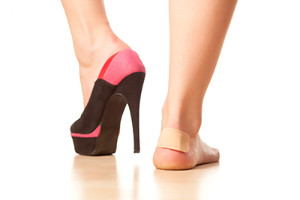 Many women who enjoy wearing high heels may be unaware of the possible harm these types of shoes may do to the feet. When high heels are worn, the weight of the body may get shifted to the joint under the big toe. This may result in the formation of a bunion, which is characterized by a bony protrusion on the side of the big toe. Corns and calluses may form on the bottom of the foot and may result in metatarsalgia. This type of pain is typically felt in the ball of the foot. If you have pain in your heel and surrounding areas, it may lead to a condition that is referred to as plantar fasciitis. It may be similar to the pain and discomfort that is experienced with heel spurs, and both conditions may develop as a result of frequently wearing high heels. If you have any of these symptoms, please consult with a podiatrist who can guide you toward proper treatment.
Many women who enjoy wearing high heels may be unaware of the possible harm these types of shoes may do to the feet. When high heels are worn, the weight of the body may get shifted to the joint under the big toe. This may result in the formation of a bunion, which is characterized by a bony protrusion on the side of the big toe. Corns and calluses may form on the bottom of the foot and may result in metatarsalgia. This type of pain is typically felt in the ball of the foot. If you have pain in your heel and surrounding areas, it may lead to a condition that is referred to as plantar fasciitis. It may be similar to the pain and discomfort that is experienced with heel spurs, and both conditions may develop as a result of frequently wearing high heels. If you have any of these symptoms, please consult with a podiatrist who can guide you toward proper treatment.
High heels have a history of causing foot and ankle problems. If you have any concerns about your feet or ankles, contact one of our podiatrists from New Tampa Foot & Ankle. Our doctors can provide the care you need to keep you pain-free and on your feet.
Effects of High Heels on the Feet
High heels are popular shoes among women because of their many styles and societal appeal. Despite this, high heels can still cause many health problems if worn too frequently.
Which Parts of My Body Will Be Affected by High Heels?
- Ankle Joints
- Achilles Tendon – May shorten and stiffen with prolonged wear
- Balls of the Feet
- Knees – Heels cause the knees to bend constantly, creating stress on them
- Back – They decrease the spine’s ability to absorb shock, which may lead to back pain. The vertebrae of the lower back may compress.
What Kinds of Foot Problems Can Develop from Wearing High Heels?
- Corns
- Calluses
- Hammertoe
- Bunions
- Morton’s Neuroma
- Plantar Fasciitis
How Can I Still Wear High Heels and Maintain Foot Health?
If you want to wear high heeled shoes, make sure that you are not wearing them every day, as this will help prevent long term physical problems. Try wearing thicker heels as opposed to stilettos to distribute weight more evenly across the feet. Always make sure you are wearing the proper shoes for the right occasion, such as sneakers for exercising. If you walk to work, try carrying your heels with you and changing into them once you arrive at work. Adding inserts to your heels can help cushion your feet and absorb shock. Full foot inserts or metatarsal pads are available.
If you have any questions please feel free to contact our office located in Wesley Chapel, FL . We offer the newest diagnostic and treatment technologies for all your foot and ankle needs.
Why High Heels Are Not Ideal for Healthy Feet
It is no secret that high heels are uncomfortable to wear for long periods of time. Although beauty is pain, you should not sacrifice the health of your feet for a stylish heel. Wearing high heels can potentially cause many different foot conditions that may be avoided by wearing proper footwear.
The structure of high heels forces weight of your body to get shifted forward toward the ball of the foot. The higher the heel you wear, the more weight and pressure get shifted forward. The pressure that your toes may experience from wearing heels may lead to hammer toes, bunions, and ingrown toenails. Extra weight and pressure resulting from wearing heels may cause stress fractures. Furthermore, heels may cause pinched nerves which may result in Morton’s neuroma.
High heels are even more dangerous for people who are clumsy. Falling or tripping while wearing heels can cause an ankle sprain or twist.
What many people don’t know is that heels can also cause back and knee problems. In order for your body to stay balanced on heels, your spine has to sway unnaturally, which adds stress to your spine muscles. This may cause you to experience a sore lower back.
If you decide to wear high heels regardless of the risks associated with them, there are ways you can minimize their harmful effects. One way to reduce injury is to massage and stretch your legs at the end of the day. Stretching can prevent the Achilles tendons and calf muscles from becoming too tight. If you are simply looking for more height, wedges and platforms provide a better surface area to distribute the body weight across compared to thinner heels.
If you experience pain from wearing high heels, it is important to see a podiatrist before any of your symptoms become worse.
How To Spot a Broken Foot
 The foot is a complicated part of the body, because it is comprised of many bones. All of these bones are at risk of breaking, which would result in a broken foot. Pain and swelling will occur if there are any broken bones in the foot. Depending on which bone is broken, you may or may not be able to put weight on your foot and walk. Broken toes are usually much more functional and don’t restrict the injured person from walking entirely. Even if it is possible to walk on the broken foot it is best not to, because putting weight on the foot can easily cause more damage. There is usually bruising or redness visible on a broken foot and any deformities that look like a dislocation are a sign of a fracture. If you think you may have broken your foot, then it is strongly recommended that you speak with a podiatrist to ensure that it heals properly.
The foot is a complicated part of the body, because it is comprised of many bones. All of these bones are at risk of breaking, which would result in a broken foot. Pain and swelling will occur if there are any broken bones in the foot. Depending on which bone is broken, you may or may not be able to put weight on your foot and walk. Broken toes are usually much more functional and don’t restrict the injured person from walking entirely. Even if it is possible to walk on the broken foot it is best not to, because putting weight on the foot can easily cause more damage. There is usually bruising or redness visible on a broken foot and any deformities that look like a dislocation are a sign of a fracture. If you think you may have broken your foot, then it is strongly recommended that you speak with a podiatrist to ensure that it heals properly.
A broken foot requires immediate medical attention and treatment. If you need your feet checked, contact one of our podiatrists from New Tampa Foot & Ankle. Our doctors can provide the care you need to keep you pain-free and on your feet.
Broken Foot Causes, Symptoms, and Treatment
A broken foot is caused by one of the bones in the foot typically breaking when bended, crushed, or stretched beyond its natural capabilities. Usually the location of the fracture indicates how the break occurred, whether it was through an object, fall, or any other type of injury.
Common Symptoms of Broken Feet:
- Bruising
- Pain
- Redness
- Swelling
- Blue in color
- Numbness
- Cold
- Misshapen
- Cuts
- Deformities
Those that suspect they have a broken foot shoot seek urgent medical attention where a medical professional could diagnose the severity.
Treatment for broken bones varies depending on the cause, severity and location. Some will require the use of splints, casts or crutches while others could even involve surgery to repair the broken bones. Personal care includes the use of ice and keeping the foot stabilized and elevated.
If you have any questions please feel free to contact our office located in Wesley Chapel, FL . We offer the newest diagnostic and treatment technologies for all your foot and ankle needs.
Causes, Symptoms, and Treatment for a Broken Foot
One out of ten broken bones is reported to be in the feet. When an object crushes, bends, or stretches the bone beyond acceptable ranges, bones break. A break in the foot is either a fracture or a straight break.
The location of any break can tell you how the break happened. Toes, for instance, break typically as a result of something being kicked hard and with great force. Heel breaks almost always are a result of an improper landing from a tall height. Twists or sprains are the other two frequent occurrences. As with all usual breaks, they result from unexpected accident or sudden injury. As with stress fractures, breaks form as a process over time from repeated stress on already present cracks. Runners, dancers, and gymnasts are the usual athletes who receive this type of break. Stress fractures result from incredible pressure on the feet. It is no surprise these athletes bear the majority of reported fractures.
Pain, swelling, bruising, and redness are all indicative of the typical symptoms from a broken foot. Severe pain—to the point of not being able to walk—usually depends on the location of the break in the foot. Toes are on the lower scale of pain threshold, but heels are high, as are a few other particular bones. As the severity of the broken foot increases, symptoms like blueness, numbness, misshaping of the foot, cuts, or deformities will become apparent. These symptoms indicate the need to see a medical professional with access to an x-ray facility.
Prior to seeing a specialist, precautions should be taken to reduce pain and swelling. Elevate and stabilize the foot, and refrain from moving it. Immobilization of the foot is the next priority, so creating a homemade splint is acceptable. Keep in mind that while creating a splint, any increase of pain or cutting off blood circulation means that the splint should be removed immediately. Use ice to decrease swelling and relieve pain symptoms.
When dealing with a medical center, the patient should note that the treatment can vary. The treatment will depend on the severity of the fracture and the cause of the break. Crutches, splits, or casts are common treatments while surgery has been known to be used in more severe cases in order to repair the break in the bones.
Causes of Neuropathy
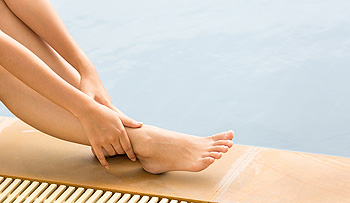 If you are experiencing a tingling sensation or a loss of feeling in your feet, you may have a condition that is known as neuropathy. It may be indicative of general health issues in the body that may cause the peripheral nerves to become damaged. Typical symptoms may include muscle weakness, or burning sensations. Possible causes of neuropathy may originate from diabetes and autoimmune disorders, in addition to certain types of chemotherapy. Patients who are older or are chronically ill may find they have symptoms of neuropathy, or it may have developed as a result of an injury. Research has shown treatments may vary based on the source of this condition, and steps can be implemented that may achieve a moderate level of relief. If the neuropathy is caused by diabetes, it is suggested to lower the insulin levels in the blood. Additionally, taking the correct supplements may heal a vitamin deficiency, which may be a cause of this condition. If you have any of these symptoms, it is advised to speak to a podiatrist who can guide you toward proper treatment.
If you are experiencing a tingling sensation or a loss of feeling in your feet, you may have a condition that is known as neuropathy. It may be indicative of general health issues in the body that may cause the peripheral nerves to become damaged. Typical symptoms may include muscle weakness, or burning sensations. Possible causes of neuropathy may originate from diabetes and autoimmune disorders, in addition to certain types of chemotherapy. Patients who are older or are chronically ill may find they have symptoms of neuropathy, or it may have developed as a result of an injury. Research has shown treatments may vary based on the source of this condition, and steps can be implemented that may achieve a moderate level of relief. If the neuropathy is caused by diabetes, it is suggested to lower the insulin levels in the blood. Additionally, taking the correct supplements may heal a vitamin deficiency, which may be a cause of this condition. If you have any of these symptoms, it is advised to speak to a podiatrist who can guide you toward proper treatment.
Neuropathy
Neuropathy can be a potentially serious condition, especially if it is left undiagnosed. If you have any concerns that you may be experiencing nerve loss in your feet, consult with one of our podiatrists from New Tampa Foot & Ankle. Our doctors will assess your condition and provide you with quality foot and ankle treatment for neuropathy.
What Is Neuropathy?
Neuropathy is a condition that leads to damage to the nerves in the body. Peripheral neuropathy, or neuropathy that affects your peripheral nervous system, usually occurs in the feet. Neuropathy can be triggered by a number of different causes. Such causes include diabetes, infections, cancers, disorders, and toxic substances.
Symptoms of Neuropathy Include:
- Numbness
- Sensation loss
- Prickling and tingling sensations
- Throbbing, freezing, burning pains
- Muscle weakness
Those with diabetes are at serious risk due to being unable to feel an ulcer on their feet. Diabetics usually also suffer from poor blood circulation. This can lead to the wound not healing, infections occurring, and the limb may have to be amputated.
Treatment
To treat neuropathy in the foot, podiatrists will first diagnose the cause of the neuropathy. Figuring out the underlying cause of the neuropathy will allow the podiatrist to prescribe the best treatment, whether it be caused by diabetes, toxic substance exposure, infection, etc. If the nerve has not died, then it’s possible that sensation may be able to return to the foot.
Pain medication may be issued for pain. Electrical nerve stimulation can be used to stimulate nerves. If the neuropathy is caused from pressure on the nerves, then surgery may be necessary.
If you have any questions, please feel free to contact our office located in Wesley Chapel, FL . We offer the newest diagnostic and treatment technologies for all your foot care needs.
How to Prevent a Corn from Developing
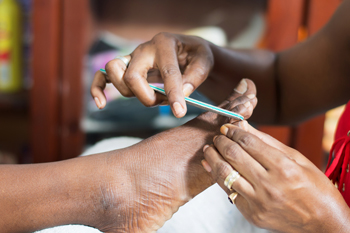 Corns are generally a common ailment where many people seek the advice of a podiatrist. Pressure is typically the cause of most corns, and this may be a result of pressure the toe endures. If shoes or socks are worn that are too tight, the toes may rub against the material, and a corn may develop. Some patients have hammertoes, in which the toes are bent downward, and a corn may form on top of the toe in the area where the bend occurs. There are preventive measures that can be implemented which may be successful in preventing corns. These may include wearing shoes that have adequate room for the toes to move about, and using foam pads which may protect the skin between the toes. If you are experiencing pain that may be caused by a corn, it is suggested that you speak to a podiatrist who can properly guide you in maintaining and preventing corns.
Corns are generally a common ailment where many people seek the advice of a podiatrist. Pressure is typically the cause of most corns, and this may be a result of pressure the toe endures. If shoes or socks are worn that are too tight, the toes may rub against the material, and a corn may develop. Some patients have hammertoes, in which the toes are bent downward, and a corn may form on top of the toe in the area where the bend occurs. There are preventive measures that can be implemented which may be successful in preventing corns. These may include wearing shoes that have adequate room for the toes to move about, and using foam pads which may protect the skin between the toes. If you are experiencing pain that may be caused by a corn, it is suggested that you speak to a podiatrist who can properly guide you in maintaining and preventing corns.
Corns can make walking very painful and should be treated immediately. If you have questions regarding your feet and ankles, contact one of our podiatrists of New Tampa Foot & Ankle. Our doctors will treat your foot and ankle needs.
Corns: What Are They? And How Do You Get Rid of Them?
Corns are thickened areas on the skin that can become painful. They are caused by excessive pressure and friction on the skin. Corns press into the deeper layers of the skin and are usually round in shape.
Ways to Prevent Corns
There are many ways to get rid of painful corns such as:
- Wearing properly fitting shoes that have been measured by a professional
- Wearing shoes that are not sharply pointed or have high heels
- Wearing only shoes that offer support
Treating Corns
Although most corns slowly disappear when the friction or pressure stops, this isn’t always the case. Consult with your podiatrist to determine the best treatment option for your case of corns.
If you have any questions please feel free to contact our office located in Wesley Chapel, FL . We offer the newest diagnostic and treatment technologies for all your foot and ankle needs.
How Your Diet Could Be Affecting Your Gout
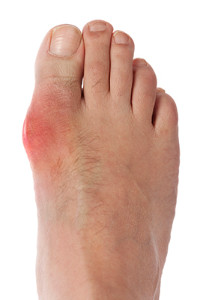 Gout is a form of arthritis, that involves bouts of pain, swelling, redness, and tenderness in the joints. It can affect any joint in the body, but it is most commonly found in the joint at the base of the big toe. The symptoms usually occur sporadically, but flare ups will come unexpectedly. The pain can last anywhere from hours to weeks after the initial flare up. Gout happens when uric acid builds up in the blood, because there is too much for the body to properly dispose of it. Uric acids are a byproduct of purines after they are broken down. Therefore, avoiding purine heavy foods could help avoid or lessen painful flare ups of gout. Some high-purine foods to avoid include: any alcohol, anchovies, herring, cod, mussels, bacon, turkey, veal, venison, organ meats, trout, meat-based gravies and sauces, and yeast extract supplements. If you would like any additional information on how your diet might affect your gout, then it is recommended that you speak with a podiatrist.
Gout is a form of arthritis, that involves bouts of pain, swelling, redness, and tenderness in the joints. It can affect any joint in the body, but it is most commonly found in the joint at the base of the big toe. The symptoms usually occur sporadically, but flare ups will come unexpectedly. The pain can last anywhere from hours to weeks after the initial flare up. Gout happens when uric acid builds up in the blood, because there is too much for the body to properly dispose of it. Uric acids are a byproduct of purines after they are broken down. Therefore, avoiding purine heavy foods could help avoid or lessen painful flare ups of gout. Some high-purine foods to avoid include: any alcohol, anchovies, herring, cod, mussels, bacon, turkey, veal, venison, organ meats, trout, meat-based gravies and sauces, and yeast extract supplements. If you would like any additional information on how your diet might affect your gout, then it is recommended that you speak with a podiatrist.
Gout is a painful condition that can be treated. If you are seeking treatment, contact one of our podiatrists from New Tampa Foot & Ankle. Our doctors will treat your foot and ankle needs.
What Is Gout?
Gout is a form of arthritis that is characterized by sudden, severe attacks of pain, redness, and tenderness in the joints. The condition usually affects the joint at the base of the big toe. A gout attack can occur at any random time, such as the middle of the night while you are asleep.
Symptoms
- Intense Joint Pain - Usually around the large joint of your big toe, and it most severe within the first four to twelve hours
- Lingering Discomfort - Joint discomfort may last from a few days to a few weeks
- Inflammation and Redness -Affected joints may become swollen, tender, warm and red
- Limited Range of Motion - May experience a decrease in joint mobility
Risk Factors
- Genetics - If family members have gout, you’re more likely to have it
- Medications - Diuretic medications can raise uric acid levels
- Gender/Age - Gout is more common in men until the age of 60. It is believed that estrogen protects women until that point
- Diet - Eating red meat and shellfish increases your risk
- Alcohol - Having more than two alcoholic drinks per day increases your risk
- Obesity - Obese people are at a higher risk for gout
Prior to visiting your podiatrist to receive treatment for gout, there are a few things you should do beforehand. If you have gout you should write down your symptoms--including when they started and how often you experience them, important medical information you may have, and any questions you may have. Writing down these three things will help your podiatrist in assessing your specific situation so that he or she may provide the best route of treatment for you.
If you have any questions, please feel free to contact our office located in Wesley Chapel, FL . We offer the newest diagnostic and treatment technologies for all your foot care needs.
Foot Soaks and Cracked Heels
 If you have ever experienced the condition known as cracked heels, you are most likely aware of the pain and discomfort it may cause. It may be a result of wearing shoes or sandals that are backless, standing for extended periods of time, or medical conditions that may consist of athlete’s foot or psoriasis. There are methods that can be implemented, which may achieve a desired level of comfort, which may include soaking the feet in warm water with specific essential oils. This may aid in moisturizing the skin and reducing the cracks or fissures that are present. Additionally, many patients find it beneficial to exfoliate the skin on their heels, and this may be achieved by utilizing a loofah or pumice stone. If you have severely cracked heels, it is recommended to consult with a podiatrist who can offer additional treatment and preventative methods.
If you have ever experienced the condition known as cracked heels, you are most likely aware of the pain and discomfort it may cause. It may be a result of wearing shoes or sandals that are backless, standing for extended periods of time, or medical conditions that may consist of athlete’s foot or psoriasis. There are methods that can be implemented, which may achieve a desired level of comfort, which may include soaking the feet in warm water with specific essential oils. This may aid in moisturizing the skin and reducing the cracks or fissures that are present. Additionally, many patients find it beneficial to exfoliate the skin on their heels, and this may be achieved by utilizing a loofah or pumice stone. If you have severely cracked heels, it is recommended to consult with a podiatrist who can offer additional treatment and preventative methods.
Cracked heels are unsightly and can cause further damage to your shoes and feet. If you have any concerns, contact one of our podiatrists from New Tampa Foot & Ankle. Our doctors can provide the care you need to keep you pain-free and on your feet.
Cracked Heels
Cracked heels appear unappealing and can make it harder for you walk around in sandals. Aside from looking unpleasant, cracked heels can also tear stockings, socks, and wear out your shoes. There are several methods to help restore a cracked heel and prevent further damage.
How Do You Get Them?
Dry skin is the number one culprit in creating cracked heels. Many athletes, walkers, joggers, and even swimmers suffer from cracked heels. Age and skin oil production play a role to getting cracked heels as well.
Promote Healing
Over the counter medicines can help, especially for those that need instant relief or who suffer from chronic dry feet.
Wear Socks – Wearing socks with medicated creams helps lock in moisture.
Moisturizers – Applying both day and night will help alleviate dryness which causes cracking.
Pumice Stones – These exfoliate and remove dead skin, which allows for smoother moisturizer application and better absorption into the skin.
Change in Diet
Eating healthy with a well-balanced diet will give the skin a fresh and radiant look. Your body responds to the kinds of food you ingest. Omega-3 fatty acids and zinc supplements can also revitalize skin tissue.
Most importantly, seek professional help if unsure how to proceed in treating cracked heels. A podiatrist will help you with any questions or information needed.
If you have any questions, please feel free to contact our office located in Wesley Chapel, FL . We offer the newest diagnostic and treatment technologies for all your foot care needs.
Ankle Sprains May Cause Ankle Pain
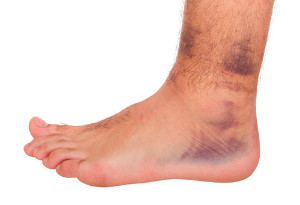 Many people will experience some type of ankle pain at some point in their lives. If you have fallen and have injured the ligaments, you may have what is referred to as an ankle sprain. These ligaments aid in connecting the leg bones to the foot and may often become injured as a result of a fall that has occurred. There may be noticeable symptoms appearing, which may include bruising, the inability to walk on the ankle, pain and discomfort, or swelling. To determine if the ankle is sprained or broken, a proper diagnosis is performed, which will typically include having an X-ray taken. If the injury appears to be severe, an MRI may be taken, which may be helpful in observing detailed images of the ankle. There are several ways to treat an ankle sprain, and it is suggested to speak with a podiatrist who can properly guide you toward choosing the correct treatment option.
Many people will experience some type of ankle pain at some point in their lives. If you have fallen and have injured the ligaments, you may have what is referred to as an ankle sprain. These ligaments aid in connecting the leg bones to the foot and may often become injured as a result of a fall that has occurred. There may be noticeable symptoms appearing, which may include bruising, the inability to walk on the ankle, pain and discomfort, or swelling. To determine if the ankle is sprained or broken, a proper diagnosis is performed, which will typically include having an X-ray taken. If the injury appears to be severe, an MRI may be taken, which may be helpful in observing detailed images of the ankle. There are several ways to treat an ankle sprain, and it is suggested to speak with a podiatrist who can properly guide you toward choosing the correct treatment option.
Ankle pain can be caused by a number of problems and may be potentially serious. If you have ankle pain, consult with one of our podiatrists from New Tampa Foot & Ankle. Our doctors will assess your condition and provide you with quality foot and ankle treatment.
Ankle pain is any condition that causes pain in the ankle. Due to the fact that the ankle consists of tendons, muscles, bones, and ligaments, ankle pain can come from a number of different conditions.
Causes
The most common causes of ankle pain include:
- Types of arthritis (rheumatoid, osteoarthritis, and gout)
- Ankle sprains
- Broken ankles
- Achilles tendinitis
- Achilles tendon rupture
- Stress fractures
- Bursitis
- Tarsal tunnel syndrome
- Plantar fasciitis
Symptoms
Symptoms of ankle injury vary based upon the condition. Pain may include general pain and discomfort, swelling, aching, redness, bruising, burning or stabbing sensations, and/or loss of sensation.
Diagnosis
Due to the wide variety of potential causes of ankle pain, podiatrists will utilize a number of different methods to properly diagnose ankle pain. This can include asking for personal and family medical histories and of any recent injuries. Further diagnosis may include sensation tests, a physical examination, and potentially x-rays or other imaging tests.
Treatment
Just as the range of causes varies widely, so do treatments. Some more common treatments are rest, ice packs, keeping pressure off the foot, orthotics and braces, medication for inflammation and pain, and surgery.
If you have any questions, please feel free to contact our office located in Wesley Chapel, FL . We offer the newest diagnostic and treatment technologies for all your foot care needs.

